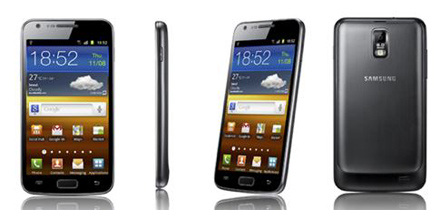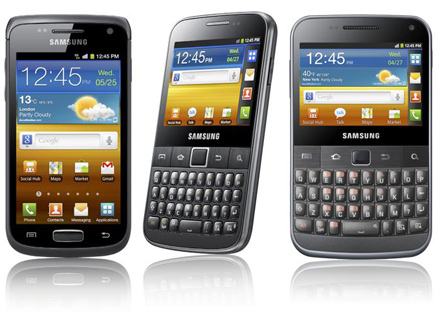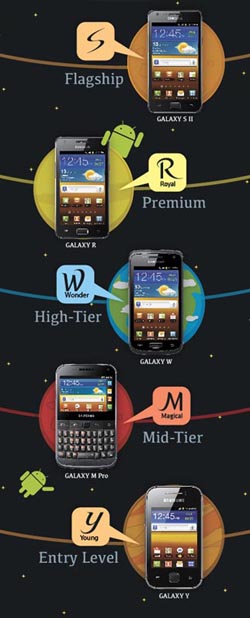UPDATED: Samsung to roll out 4G/LTE Galaxy S II smartphone at IFA, as it pushes for world phone market leadership
New model, part of a range of new Galaxy phones, has slightly revised design, claims to be world's first high-speed LTE/WCDMA/GSM multimode phone


UPDATED: Samsung will use the IFA show, opening in Berlin this week, to launch a new 4G smartphone, the Galaxy S II LTE (above). It's part of the company's efforts to seize the initiative in next-generation high-speed phones, capable of handling data much faster than current models.
The new S II will have a slightly revised design, but most important is its compatibility with superfast 4G/LTE (Long Term Evolution) phone services. These are capable of providing peak download rates of at least 100Mb/s, and upload speeds of more than half that, and Samsung is determined to be at the forefront of this technology.
J.K. Shin, president of the company's mobile division, says 'This is a milestone in our commitment to lead the charge in 4G mobile telephony around the world, both in terms of back-end network solutions for service providers and the development of powerful consumer handsets.'
He also announced that the company will begin selling an LTE-enabled version of its Galaxy Tab tablet device later this year.
The Galaxy Tab S II LTE is said to be the world's first LTE/WCDMA/GSM multimode phone, and will have an 11.45cm Super AMOLED Plus display, 1.5GHz dual-core processor, and an 8-megapixel camera.
It will also feature Near Field Communication, or NFC, enabling it to be used to make payments using stored credit card data, simply by waving the phone close to, or touching it on, a reader in a shop. NFC can also be used to transfer data between compatible devices.
Posted 25.08.11
Get the What Hi-Fi? Newsletter
The latest hi-fi, home cinema and tech news, reviews, buying advice and deals, direct to your inbox.

Samsung wants to be the world's biggest mobile phone maker – and it aims to do it by targeting both the smartphone market and countries with growing mobile industries, focusing its products at specific users and exploiting next-generation technology.
That's the view from Hong Won-pyo, Executive Vice President of the company's mobile phone division, speaking yesterday at the company's weekly executive meeting in Seoul.
His comments came on the same day the company launched not only a new naming scheme for its growing Galaxy smartphone range, designed to target models more specifically at different sectors of the market, but also four new Galaxy phones, due to be showcased at next week's IFA show in Berlin, Germany.
Tie-up with LG on next-gen tech
And as if all that wasn't enough to signal Samsung's ambitions, it was also announced yesterday that the company will join forces with LG to build the core technology for next-generation 4G LTE (Long Term Evolution) phones.
Until now LG has been making its LTE chips, able to handle HD video and data at higher speeds than current phones, with a Taiwanese chipmaker, but now it has moved production to a Samsung plant.
The two have already completed the development of a new platform using the LTE chip, which is thought to be set to launch in the next couple of months.

Naming new Galaxies
The new naming system for Samsung's Galaxy smartphones sees the existing S (for 'Super Smart') models retaining their flagship status, but being joined by several more layers of phones.
R (for 'Royal') will be premium models aimed at having a combination of 'power, design and productivity', while W ('Wonder') phones will be 'high quality strategic models.
M (''Magical') models will have 'decent performance at affordable prices'.
Finally there's the Y ('Young') range, not surprisingly aimed at younger buyers, especially in emerging markets, with entry-level pricing.
Still with us? Within these main product ranges there will also be sub-classes: 'Plus' will be an upgrade to an existing model, 'Pro' will add a QWERTY keyboard, and 'LTE' will have – you guessed it – LTE support.
Four new phones are on the way for IFA: a W, an M, and two Ys.
The Galaxy M Pro has a look remeniscent of BlackBerry/Nokia E-Series about it, with its QWERTY keyboard.
It runs Android 2.3 and sports a 6.75cm display and has a 1HGz processor, 7.2Mbps HSDPA and twin cameras.
The Galaxy W runs the same OS, has a 9.4cm display, a 1.4GHz processor, 14.4Mbps HSDPA and a 5-megapixel camera. It also has extensive gaming, social networking and music capabilities.
The two Y-series phones are the Galaxy Y and Galaxy Y Pro.
Both have a 832MHz processor and run Android 2.3, but while the Y has a 7.5cm display and a 2MP camera, the Y Pro has a QWERTY keyboard, 6.6cm display and 3-megapixel camera.
Growing global share
These models are all part of Samsung's strategy to grow its market share in smartphones, not to mention the overall worldwide mobile phone market. Hong explained that whereas smartphones accounted for 22% of a global market of 1.36bn phones last year, this year it's expected to be some 27% of a total 1.55bn – 40% growth.
By value, smartphones accounted for 54% of the $183bn (£115bn) market last year, and will be 64% of a $200bn (£125bn) total this year, a rise of over 28%.
On the Korean market, smartphone sales have gone from 16% in the first three months of 2010 to 72% in the same period this year, and are now thought to be above 80%, while the figures increased from 31% to 49% in North America, 29% to 49% in Europe, and 16% to 25% in the whole Asia-Pacific region. Even in Latin America and the Middle East/Asia there was substantial growth.
400% tablet growth target, too
And Hong says tablet PC growth will be even more spectacular: 18m tablet devices were sold worldwide last year, but this year that figure will be 59m, and by 2015 it will be 150m. Samsung aims to increase sales five-fold in this sector.
In phones, Hong says that the Samsung plan is to capitalise on worldwide growth by targeting all three major phone sectors – smartphones, premium phones and entry-level models.
It'll do this by launching new models in the smartphone sector, which it leads, strengthening its dominance in the premium market, and attacking emerging markets with new entry-level models.
Follow whathifi.com on Twitter
Andrew has written about audio and video products for the past 20+ years, and been a consumer journalist for more than 30 years, starting his career on camera magazines. Andrew has contributed to titles including What Hi-Fi?, Gramophone, Jazzwise and Hi-Fi Critic, Hi-Fi News & Record Review and Hi-Fi Choice. I’ve also written for a number of non-specialist and overseas magazines.
